OneSkin offers a line of skin longevity treatment products that leverage the proprietary OS-01 peptide, which the company claims can extend skin health on a molecular level.
For this review, I used OneSkin’s OS-01 face and body lotions for several months to see if they could change the appearance of my skin. Additionally, I dug into the scientific literature to find out more about the mechanisms of action behind the OS-01 peptide.
Continue reading to find out how effective OneSkin OS-01 was and to see my before and after photos.
OneSkin OS-01

Summary
OneSkin OS-01 is an effective longevity treatment that uses a proprietary peptide to improve skin health on a cellular level. I’ve used OneSkin OS-01 for several months and it dramatically improved the appearance of my skin.
Why Skin Health Is Important
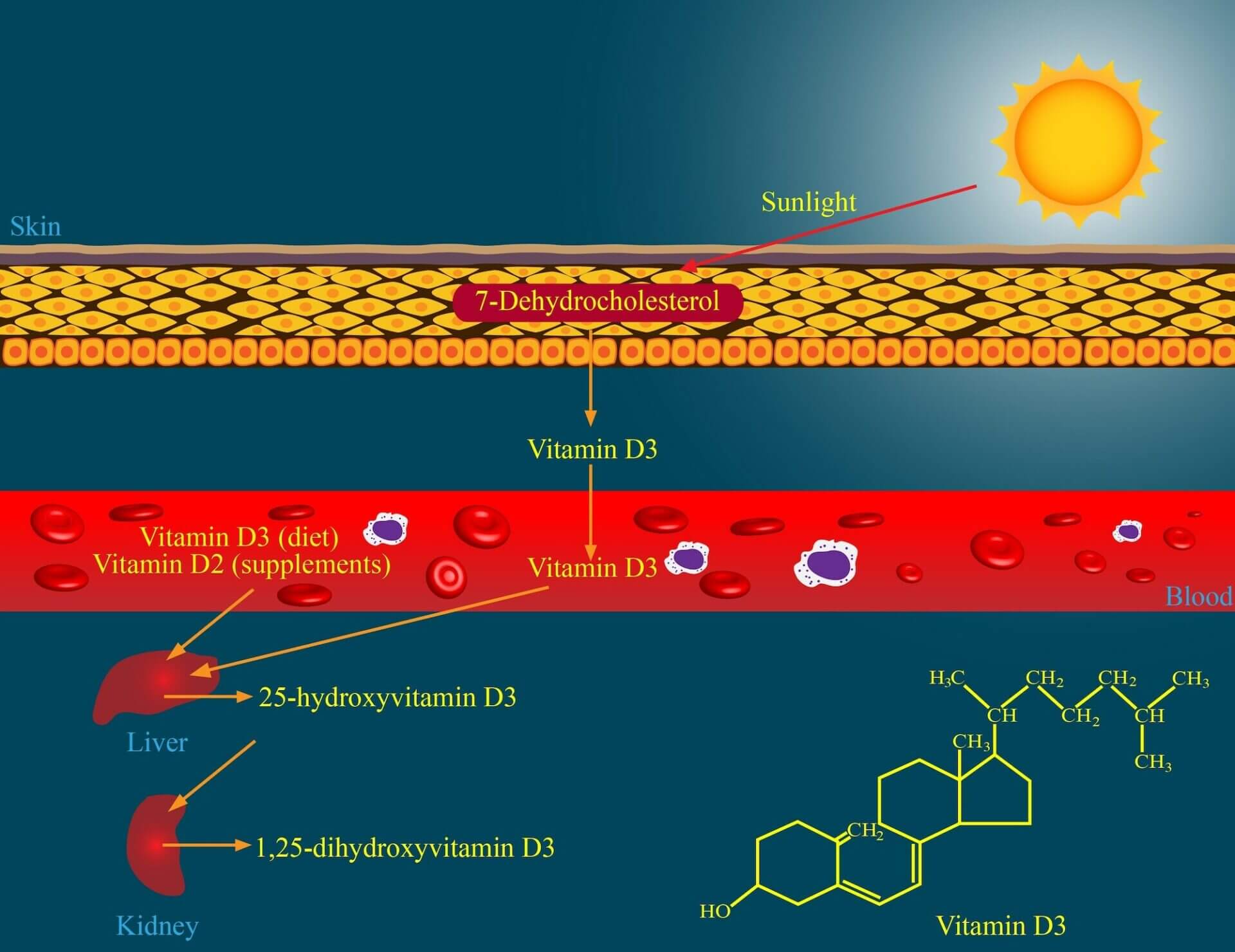
Having healthy skin isn’t just about how you look. The skin is the human body’s largest organ, and much more than a mechanical barrier; it also helps to regulate body temperature, is part of the respiratory system, and is involved in hormone production (including vitamin D production). As a result, it’s critical to keep your skin healthy and functioning optimally.
Additionally, your skin is quick to show you when something inside your body isn’t working correctly. For example, smoking, chronic exposure to stress, poor sleep or consuming inflammatory foods such as processed carbohydrates, industrial seed oils (e.g, canola oil) or vegetables (all plants have toxins) can negatively impact the appearance of your skin.
In other words, if you suffer from acne, eczema, dry skin or similar conditions, it’s likely due to one or more of the factors mentioned above.
Aside from inflammatory skin diseases that should be treated by implementing appropriate lifestyle changes, the natural process of aging can lead to the appearance of wrinkles, fine lines and so-called “age spots.”
Scientists have yet to figure out how to stop the aging process, but there has been significant progress in determining what happens in our bodies on a cellular level when we age. This progress has led to the development of certain treatments that can slow down some of the common signs of aging.
In my article on how to slow down aging (which outlines my anti-aging regimen), I touch on the fact that cell death (cell senescence) and the accumulation of senescent cells is one of the hallmarks of aging.
Preventing cell senescence and helping the body clean up senescent cells in your skin is what OneSkin is trying to do with its OS-01 peptide. That’s what got me so excited about giving OneSkin a try.
OneSkin OS-01 Review
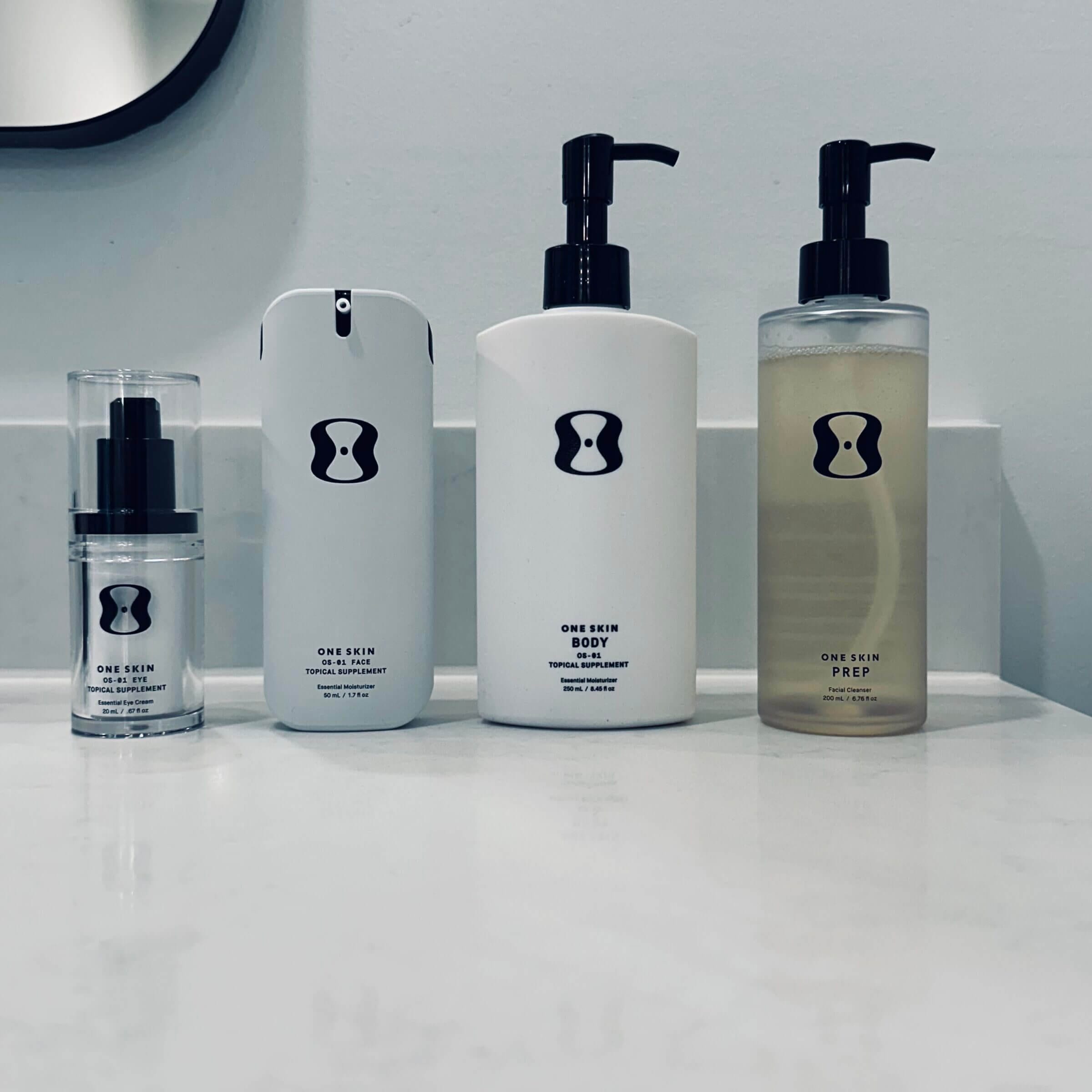
Pros
- Scientifically proven to work.
- Effective at reducing age spots, fine lines and wrinkles.
- Easy to apply and feels lightweight on your skin.
- Clean ingredients.
- Available for eyes, face, body and as a sunscreen.
- You can see results in as little as four weeks.
Cons
- Price.
As of this writing, OneSkin offers five different products as part of its skincare lineup:
- Face lotion (OS-01 FACE).
- Body lotion (OS-01 BODY).
- Topical eye supplement (OS-01 EYE).
- Mineral-based sunscreen (OS-01 SHIELD)
- Facial Cleaners (PREP)
I’ve been using OneSkin’s face (OS-01 FACE) and body (OS-01 BODY) lotions for more than two months, but for the remainder of this review, I’ll be focusing on OneSkin’s flagship product, OS-01 FACE.
Benefits of the OneSkin OS-01 Peptide

OneSkin claims that its proprietary OS-01 peptide offers the following skin health benefits:
- Increased epidermal thickness, leading to fewer wrinkles and more protection against external stressors.
- Improved collagen production, leading to increased skin firmness and strength.
- Reduced DNA damage and improved overall cell function.
- Improved skin texture and smoothness, making your skin feel and look better.
- Reduced accumulation of aged and dead cells (senescent cells).
- Increased skin hydration (by preventing water loss and increasing the production of hyaluronic acid).
To back up the benefits OneSkin observed in the lab using skin models grown from donor cells, the company teamed up with a third-party contract research organization (CRO) and researchers from the School of Pharmaceutical Sciences at the University of São Paulo and the Spanish National Cancer Research Center (CNIO) to design a 12-week clinical study involving 22 female test subjects between the ages of 22 and 65 years with various skin types.
The study confirmed that the OS-01 peptide was effective in reducing both the visible and invisible signs of aging.
Specifically, the scientists concluded that OneSkin’s topical supplement:
- Improved the skin barrier by 15% on average.
- Improved skin elasticity in 90% of users.
- Improved skin evenness, radiance, pores and firmness in 95.5% of users.
- Reduced the appearance of fine lines and wrinkles in 87% of users.
- Improved skin smoothness and overall appearance in all test subjects.
The results were measured using a combination of instrumental evaluation (vapor meter analysis) and a double-blind expert clinical grader evaluation.
For example, the scientists used a vapor meter to objectively measure transepidermal water loss. However, changes in cosmetic appearance (e.g., reduction of fine lines and wrinkles) was evaluated by comparing before and after photos (much like what I did for this review).
I know what you might be thinking at this point: the study was sponsored by OneSkin, so the results might be skewed in the company’s favor.
There is obviously a conflict of interest here, but based on what I’ve read about how the study was designed and conducted — combined with the results of my own testing — I believe OS-01 to be effective.
Ingredients
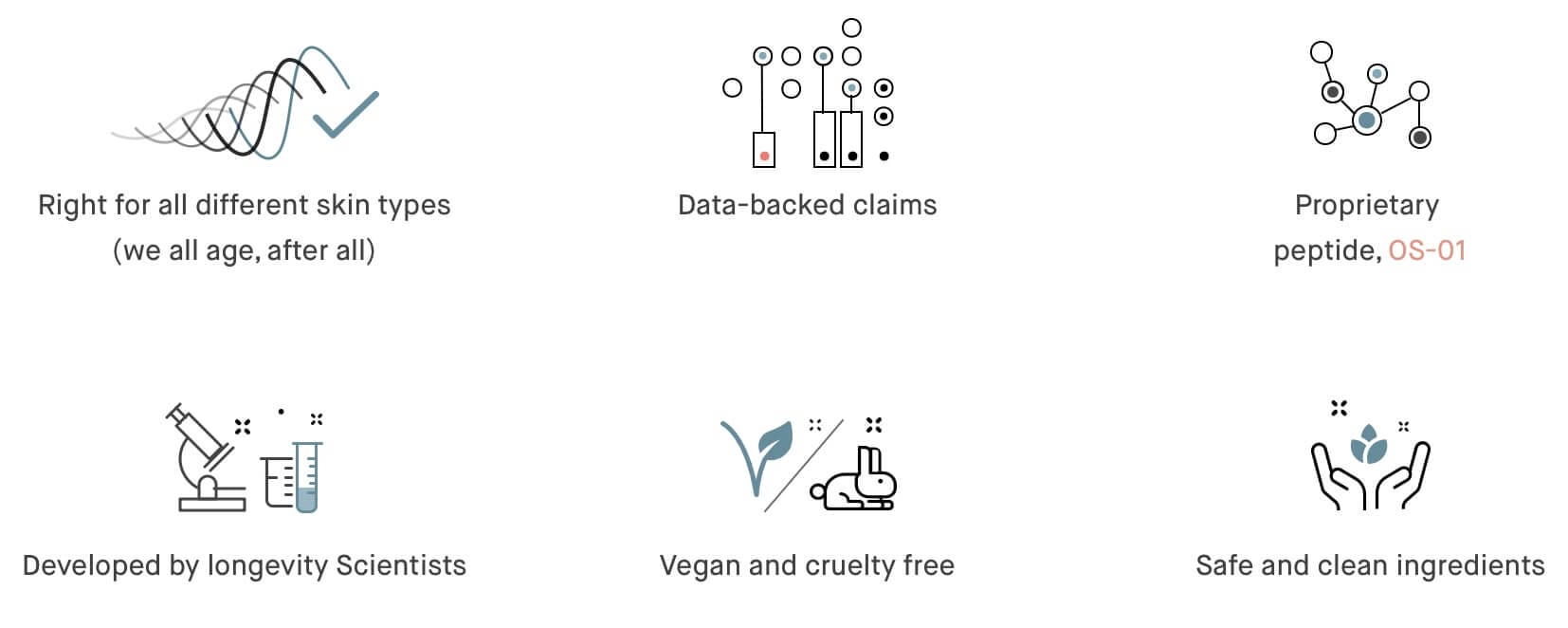
OneSkin contains a combination of active and inactive ingredients. The seven active key ingredients in OneSkin include:
- OS-01 peptide (the company’s secret sauce).
- Pracaxi oil, which has moisturizing, anti-inflammatory, antioxidant, antibacterial and antifungal properties.
- Andiroba oil, which promotes collagen production and has anti-inflammatory properties.
- Niacinamide, which also has moisturizing, anti-inflammatory, antioxidant, antibacterial and antifungal properties.
- Oleic pau mulato extract, which heals skin abrasion and smooths wrinkles by making skin more stress resistant.
- Allantoin, which helps moisturize skin and reduce irritation.
- Three sizes of hyaluronic acid to help stimulate collagen and elastin production and maintenance, and to aid in epidermal regeneration, stem cell maintenance and moisture retention.
Aside from these active ingredients, OneSkin’s face lotion also contains a few dozen inactive ingredients, including thickeners and preservatives.
Any time I pick up a skincare product, I pay especially close attention to the list of (often cryptic) inactive ingredients, because that’s how most skincare manufacturers sneak in chemicals that can be detrimental to your health.
While you can look up the ingredients list on the OS-01 FACE product page, I only noticed one ingredient that looked suspicious: phenoxyethanol, an antimicrobial preservative. If you’ve read my article about the endocrine-disrupting properties of xenoestrogens, you might remember to steer clear of any ingredients that contain the prefix “phen.”
So I dug a little deeper and found out that phenoxyethanol can be problematic in very high doses. However, you’d need about 200 times the amount of what OneSkin put into its lotion to trigger any adverse systemic effects. That’s why the European Scientific Committee on Consumer Safety declared phenoxyethanol safe for all consumers. Knowing that Europe is much stricter when it comes to banning potentially unhealthy ingredients in cosmetic products, I feel at ease putting phenoxyethanol on my skin.
Speaking of endocrine-disrupting chemicals, I really appreciate that OneSkin decided not to use any fragrances, which are often a source of phthalates (another class of endocrine disruptors).
Overall, I consider OneSkin’s skincare products safe for daily use thanks to their clean ingredients.
Packaging

One complaint I have about expensive skincare products is that they often come in packaging that makes it impossible to use the entire contents. That’s particularly true for products that come in a hard plastic shell with a pump.
Fortunately, OneSkin decided to use sustainable packaging that gives you visibility into the amount of remaining product and the ability to squeeze out every last drop of the pouch. As a bonus, you can help reduce plastic waste by keeping the outer hard plastic shell when you order refill pouches.
I wish more skincare companies would follow in OneSkin’s footsteps to increase their product value and reduce plastic waste.
Pricing
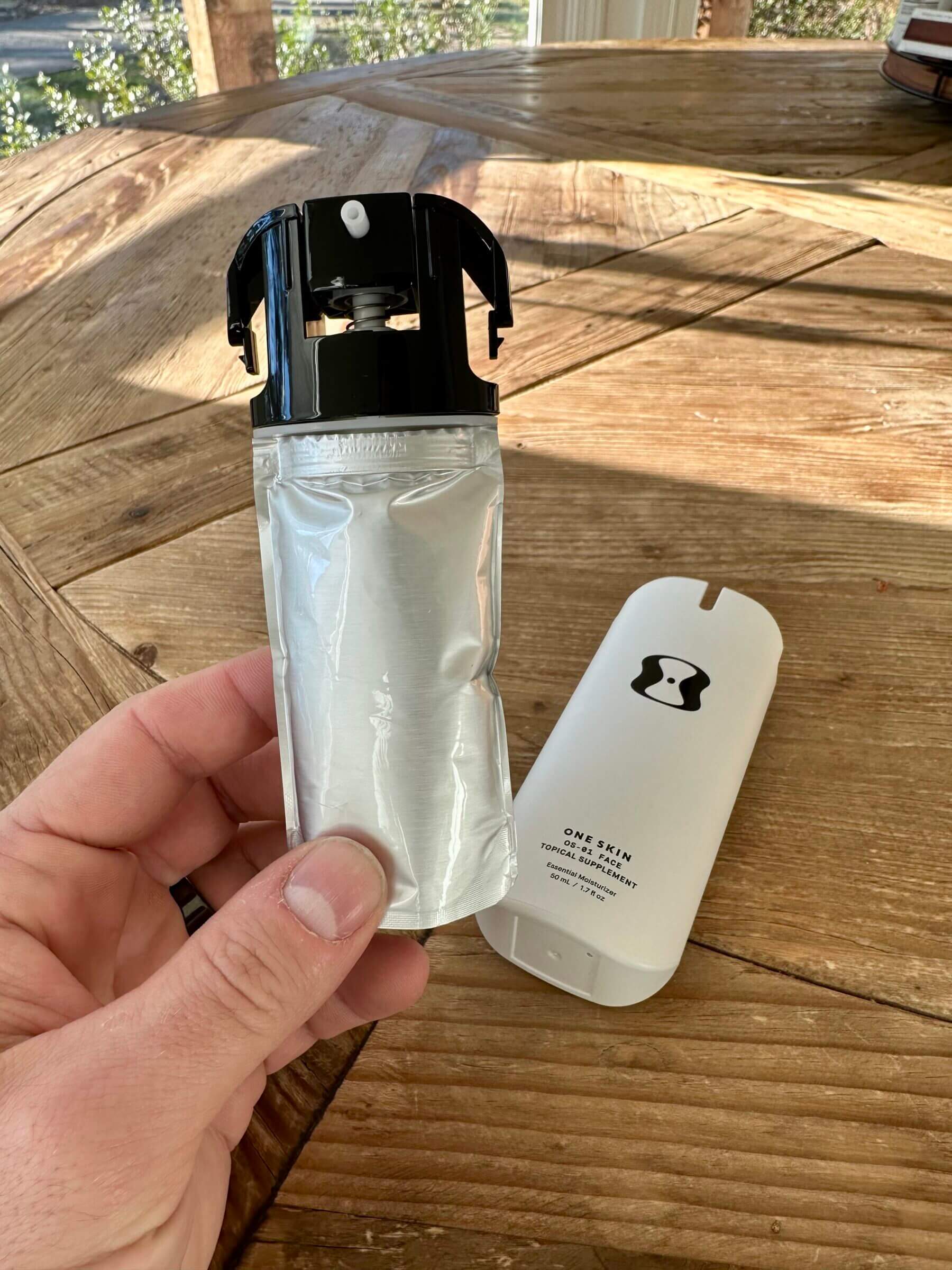
The only downside to OneSkin’s OS-01 skincare product is the price tag. At $120 for a starter kit (the refill pouch costs $117), it’s not exactly cheap compared to the products you’d find at your local Walmart or Walgreens.
However, comparing OneSkin to drugstore skincare products wouldn’t be fair. It’d be more appropriate to compare OneSkin to other high-end products, including Chanel’s Hydra Beauty Micro Crème (which retails for $100) or the Sublimage La Crème, which Chanel claims is the ultimate skin regeneration product. The latter retails for a whopping $420 and contains a cocktail of endocrine-disrupting chemicals that are anything but healthy for your skin.
So from that perspective, I consider OneSkin reasonably priced. Additionally, you can sign up for a 30, 60 or 90-day subscription and save 17% over the one-time purchase price.
Additionally, OneSkin agreed to offer my readers an extra 15% discount if you use code MKUMMER. The code is valid for your first order and applies to the entire cart.
Test Results (Before and After Photos)
If you’ve come this far, you probably want to see some before and after photos of my skin. I’m 41 years old and I didn’t expect OneSkin to turn my skin into that of a 20-year-old. In fact, I didn’t really know what to expect, because I’m happy overall with the appearance of my skin.
Keep in mind that I consume a relatively healthy diet that’s devoid of inflammatory foods such as seed oils and processed carbohydrates. I’ve also never smoked, but I don’t wear sunscreen.
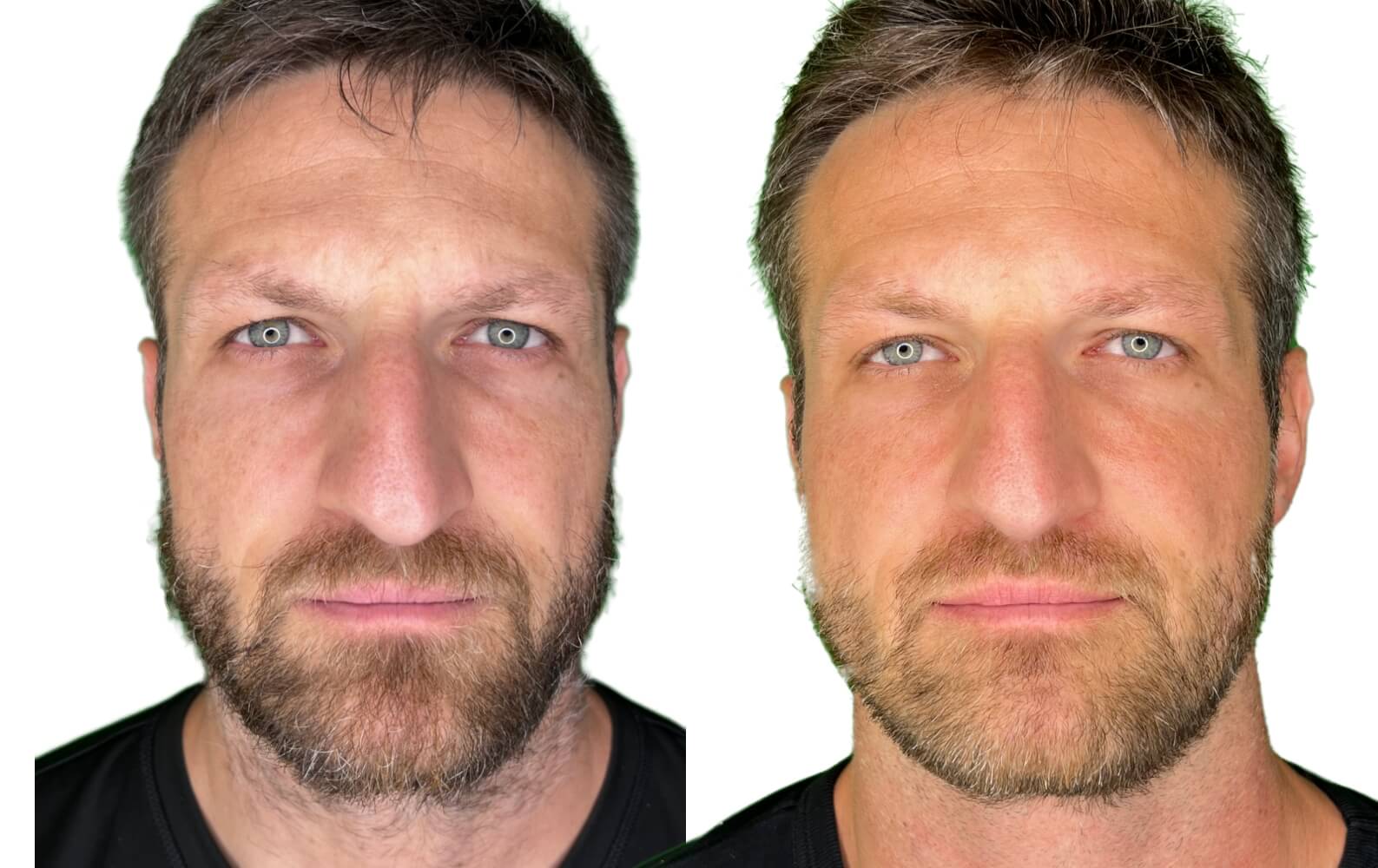
As you can see, OneSkin managed to reduce the fine lines on my forehead quite a bit.
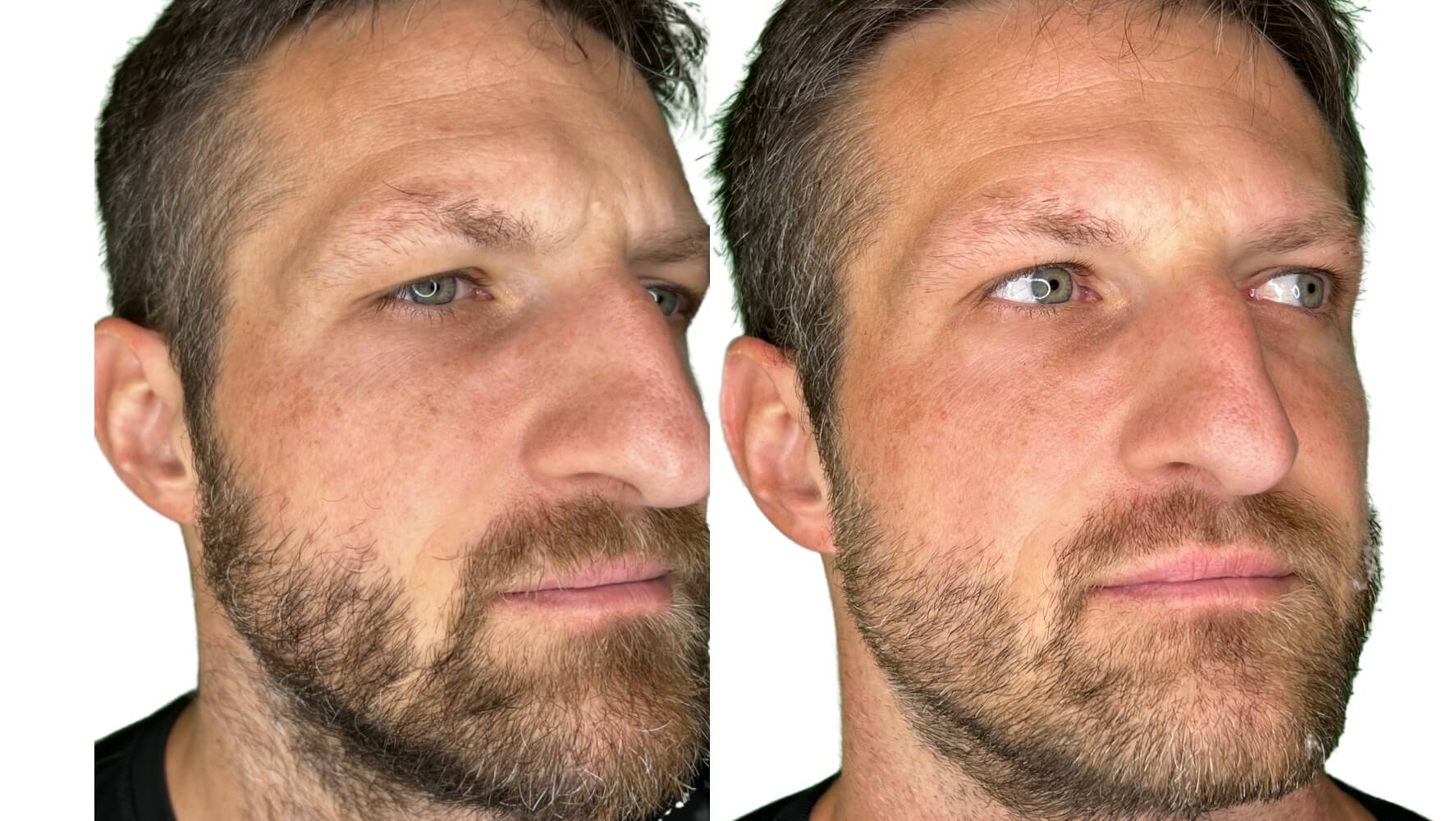
Overall, I didn’t expect miracles but I was quite impressed by the noticeable improvements in my skin’s appearance. Since then, I’ve had several people tell me that I have a more youthful appearance, even though nobody could pinpoint exactly what had changed.
Looking in the mirror, my skin appears to be a bit firmer and smoother, with softened fine lines and fewer age spots.
I’m satisfied with the results and will continue using OneSkin, paired with appropriate dietary choices, proper stress management, red light therapy and everything else I’m doing to mitigate the effects of aging.
How to Make OneSkin Even More Effective

If you want to further boost the effectiveness of OneSkin, I recommend using a high-quality red light therapy device (such as the MitoPRO 1500 I use) right after applying the OS-01 peptide. Anecdotal evidence suggests that the increased blood flow and oxidative stress from red and near-infrared light helps topical skin supplements to better penetrate through the skin and thus be more effective.
Frequently Asked Questions

I don’t recommend doing so, because the amount of OS-01 peptide in each formulation varies. The OneSkin face lotion has a higher OS-01 concentration than the body lotion, because the face’s skin usually shows more signs of aging than the skin in other areas of your body (which are less exposed to environmental stressors, including UV radiation). In other words, using the skin lotion on your face won’t likely offer the same benefits. However, you could use the face or eye product on other parts of your body.
OS-01 EYE is the latest addition to the company’s lineup, and I just started testing it while writing this review. While I don’t have enough data yet to determine how well it works, it’s worth mentioning that OS-01 EYE has the highest concentration of the OS-01 peptide, followed by OS-01 FACE.
That’s because the skin around the eyes is incredibly thin, sensitive and prone to showing visible signs of aging. On the flip side, the company’s body lotion has the least concentration of the OS-01 peptide.
OneSkin differs from other premium skincare products because of its effectiveness, its ability to actually penetrate the skin, and its lack of toxic ingredients and fragrances.
Many skincare products include ingredients that have a larger molecular weight than what can be absorbed through the skin. As you know, the skin acts as a barrier and doesn’t let everything through. As a rule of thumb, the molecular weight of any compound must be under 500 Dalton to penetrate the skin.
For example, the ginger root extract in Chanel’s moisturizer has a molecular weight of 568.8 and is thus unlikely to penetrate the skin.
Besides containing ineffective ingredients, most of those premium products also contain toxic ingredients, including artificial colors, microplastics and endocrine disruptors.
Yes, OneSkin is perfectly compatible with sensitive skin and all skin types, thanks to the lack of inflammatory ingredients and fragrances.
No, OneSkin doesn’t test its products on animals. As a result, its products are considered vegan.
Yes, OneSkin offers a 30-day money-back guarantee if you’re not satisfied with the results.
You should use OneSkin twice a day (e.g., in the morning and evening) on clean skin. OneSkin’s lab testing has revealed that using the product on clean skin can improve the absorption rate by 50%. You can use OneSkin PREP or a non-toxic cleanser of your choice.
No, unfortunately, OneSkin doesn’t sell its lotions or cleansers on Amazon. You have to go directly to oneskin.co to purchase their products.
Prescription-grade retinol creams are a popular treatment option to improve the appearance of aging skin by neutralizing free radicals and boosting the production of elastin and collagen. However, retinol doesn’t help remove senescent cells, so it doesn’t improve your skin’s longevity.
Additionally, too much retinol can cause side effects, including dry skin, flaking and redness. As a result, I consider retinol less effective than OneSkin.
Yes! OneSkin offers a travel kit that comes with a super-soft silicone pouch and travel-sized versions of the company’s most popular products, including OS-01 FACE, OS-01 BODY, OS-01 EYE and PREP. You can find the entire travel kit (and individual travel-sized product bundles without the pouch) in OneSkin’s online shop.
OneSkin sells a mineral-based sunscreen called OS-01 SHIELD that uses a combination of zinc oxide and the company’s patented OS-01 peptide to protect skin from the potential damage that UV light can induce. While I’m not a big fan of sunscreens in general, OS-01 SHIELD is likely your best choice if you plan to expose your skin to the sun for longer than it can handle (when you don’t have the option of using a physical barrier, like clothing).
Wrap-Up: Is OneSkin Worth It?
I’m not a beauty influencer and I’m not too concerned about the normal signs of aging. However, I’ve realized that despite my best efforts, my modern lifestyle exposes my skin to environmental stressors and toxins that can speed up the normal aging process.
While I do my best to mitigate those issues by following an animal-based diet, avoiding processed foods and seed oils, using a combination of natural sunlight and red light therapy devices and limiting my alcohol consumption, to name a few of the things I do, there is room to improve my skin’s biological age by addressing the root cause of skin aging: senescent cells.
That’s why I’ve made OneSkin a regular part of my skincare routine with the goal of supporting my body in removing senescent cells.
Dead skin cells are like a bad apple in a basket full of good apples. The one bad apple can cause the surrounding apples to spoil quicker. Senescent cells behave in a similar fashion, as they excrete inflammatory substances that can negatively affect the surrounding cells.
OneSkin’s face topical supplement (FACE OS-01) helps me to get rid of those senescent cells in my skin before they can cause damage, thus supporting my skin’s natural rejuvenation and skinspan.
So far, OneSkin appears to have been effective in doing exactly that. At least, I’ve seen positive changes in how my skin looks within a few weeks of treatment.
If you’re trying to improve the appearance of your skin and you’ve already laid the foundation for healthy skin (proper diet, stress management, good sleep…), I’d recommend you give OneSkin a try. Just don’t expect miracles if your lifestyle isn’t in line with your skin health goals.

Michael is a healthy living enthusiast and CrossFit athlete whose goal is to help people achieve optimal health by bridging the gap between ancestral living and the demands of modern society.
Medical Disclaimer
The information shared on this blog is for educational purposes only, is not a substitute for the advice of medical doctors or registered dieticians (which we are not) and should not be used to prevent, diagnose, or treat any condition. Consult with a physician before starting a fitness regimen, adding supplements to your diet, or making other changes that may affect your medications, treatment plan or overall health. MichaelKummer.com and its owner MK Media Group, LLC are not liable for how you use and implement the information shared here, which is based on the opinions of the authors formed after engaging in personal use and research. We recommend products, services, or programs and are sometimes compensated for doing so as affiliates. Please read our Terms and Conditions for further information, including our privacy policy.
I literally came to One Skin’s website to purchase their product until I read your ignorant comments and “dismisinformation” about sun exposure. Now I simply cannot justify spending my hard earned money on a spokesperson who spouts such utter nonsense. You sound like a six old. My god.
I know that critical thinking and questioning main stream health advice is not everyone’s cup of tea. But if it makes you feel any better, One Skin doesn’t share my opinion on sunscreens either. In fact, they’re working on one :)
Thank you for such a detailed review. It is much appreciated!
You’re most welcome, Donna!
I really strongly suggest that you make the os1 body in a refillable package. I’m on my second one and it seems almost empty but when I take the pump off and shake it upside down, I can get almost another weeks worth of product out!!!!
Thank you for your consideration. Lily Meadows
At this time my goal is for face and neck. I am a older female. what would you recommend.
Hey Peggy,
OS-01 FACE Topical Supplement would be my recommendation! See https://michaelkummer.com/go/oneskinshop
Cheers,
Michael
I completely agree with you. I’m constantly bombarded with people who think like the person you responded too. The sun has always been here. It heals us. It can even heal the skin . I’d say a majority of sunscreens contain cancer causing ingredients.
Hi Michael! What is the best way to incorporate OneSkin into your morning and evening skin care routine? Should you place this on clean skin immediately after cleansing Prior to serums? Is it effective if you apply it after serums or mix with other moisturizers? Thank you in advance, great review!
Hey Elle,
I’m by no means a skincare expert but One Skin recommend applying their products directly on clean skin. So I’d apply your serums after the lotion.
Cheers,
Michael
Michael, your photos have very different lighting. I am in my 50s and I can find photos have my face where I look so much younger than others. It’s all about the lighting. I used One Skin for 12 weeks and saw no difference.
Hey Anne,
I actually took both photos under the exact same lighting conditions (in my YouTube studio) but using two different generations of iPhone (which likely explains the difference in white balance). Have you reached out to One Skin to discuss your results (or lack thereof)?
Cheers,
Michael
Hi Michael,
Thank you for all of the above, extremely helpful. One thing I didn’t see you mention is wearing sunscreen daily. Believe me, it makes a significant difference in the appearance of your skin. Most important, it greatly decreases your likelihood of developing skin cancer. So excited to see what OneSkin can do.
Kind regards,
Cheryl
Hi Cheryl,
Thanks for stopping by! Sun exposure doesn’t cause skin cancer. It’s a myth that I debunked in one of my newsletters that, unfortunately, isn’t available online so I can’t link to it. The skin is perfectly capable of defending itself against UV rays if you consume an appropriate diet and don’t wear sunglasses (which inhibits the signals to release melanin). I’ve not worn sunscreen in two years, spend a lot of time in the sun (without a shirt) and never burn. I should probably convert that newsletter into an article to I can link to it and the scientific evidence behind my claims :)
Cheers,
Michael
You are a moron. There are literally 1000s and 1000s of scientific papers about the harmful effects of UV rays on the skin and association to skin neoplasms. LOL. It’s not about just burns, it’s about longterm, cumulative exposure to UV rays.
Don’t spread misinformation.
Have you ever asked yourself the question why skin cancer wasn’t really a thing before the invention of sunscreens and why the rates of skin cancer has skyrocketed over the past few decades despite the proliferation of sunscreen availability and use?
I don’t disregard the potential of UV light on human skin cells but evidently, humans have developed defense mechanisms to protect the skin against them (e.g., melanin).
On a side note, I’ve heard that One Skin is working on a sunscreen…do you think they’d pay me to say what I said about sunscreens?
I think you would benefit from spending some time on questioning common medical advice and trying to understand the differences between clinical trials vs. observational studies and why correlation isn’t the same as causation.
Rates of skin cancer have increased in recent decades for two reasons 1) UV radiation is higher because of the hole in the ozone layer 2) we actually know what to look for when someone has skin cancer (usually it starts of as a mole that’s an odd shape) and in Australia people get yearly skin cancer checks to catch this quickly before the cancer spreads to the rest of the body (which is what would’ve happened in previous generations).
A hundred years ago there was no hole in the ozone layer. It was noticed in the 80s. That’s why the sun is harsher in Australia/Southern hemisphere. There are plenty of Aussies who go to the US and are shocked that you don’t burn in the sun the in the same way as AUS. The ozone is known as the earths sunscreen (Google it). Your weather bureau should have a UV index for each day and it will differ for where you live and the weather of the day. Even on overcast day can have high UV rays. In an Australian summer the UV radiation is so high from 9am to 5pm on most days so you need sunscreen or you will burn but in winter you can go outside and not get burned (Melbourne) although now they are recommending sunscreen all year round. So if you haven’t been sunburned for not wearing sunscreen for two years that could mean 1) UV index is low where you live 2) you’re not outside when the UV is highest. You most likely are still damaging your skin even without the burning. That healthy tan is skin damage. You can easily get a UV skin scan and see the damage the sun has done, I’m sure you’ll be shocked by how awful your skin truly is, as most adults are. Most sun damage is done when you’re a child up to early twenties (less sunscreen used and more time outside) and skin cancer doesn’t appear for many many years (usually over 50years old when they show up). The other reason skin cancer is more diagnosed now is we actually know what to look out for. Every year I get a skin cancer check (and everyone should) where any moles on your body are checked to see if they have changed in size/shape/colour. If skin cancer is left untreated it can cause the cancer to spread to other parts of the body. So readers, just because someone with no medical background except for googling says they haven’t put sunscreen on for two years and they haven’t been burned, seriously question this and get the facts. Also check their age, these problems show up after 50/60 years old once aging has truly begun after years of skin damage. Anyway, if you’re in a moderate to high UV exposure area, wear sunscreen.
Also, I hear once you’re over 40 you cannot produce Vitamin D from going out in the sun so keep that in mind.
Hey Sophia!
I appreciate your response! One thing you don’t seem to appreciate is that (skin) damage isn’t always a bad thing. Much like exercise damages muscle tissue, it’s an important factor in triggering repair and making you more resilient. The key is to keep the rate of repair above the rate of damage. UV damage of the skin follows the same principle. As long as your body repairs the damage at a higher rate than what’s inflicted, there is no issue. And much like muscle growth is a sign of a positive ratio of repair to damage, skin darkening is a sign of improved resilience to UV radiation, not a sign of cancer-causing damage.
I certainly agree that there is such a thing as too much UV radiation, not exposing your naked skin to natural sunlight carries a significantly higher risk to adverse health outcomes than doing so.
Also, I don’t know where you heard that your body can’t produce Vitamin D once you’re over 40. I’m 41 and produce plenty of Vitamin D from regular sun exposure and sufficient fat (plus cholesterol) intake. I know because I do thorough blood panels every three months (see https://michaelkummer.com/health/metabolic-health/).
Last but not least, if you feel like wearing sunscreen because you’re in the sun for longer than your body can handle, make sure it’s a non-toxic version. Most sunscreens contain endocrine disruptors that increase your risk of developing cancer more than sunburns.
I completely agree with you. I’m constantly bombarded with people who think like the person you responded too. The sun has always been here. It heals us. It can even heal the skin . I’d say a majority of sunscreens contain cancer causing ingredients.
Very well thought out and kind response, not reaction, to a non-kind comment. Well done and good on you for not taking the bait to get into an immature bickering online. That said, I’d be very interested in reviving your newsletter on you debunking skin cancer via sun exposure. Thank you.
I’ll talk about it on an upcoming podcast episode: https://www.primalshiftpodcast.com/
Hey Michael, there’s also the factor of UV rays being much stronger. I lived in Australia and it is still has one of the highest rates of skin cancer in the world.
Just say’n :)
I don’t doubt that the UV index plays a role but it doesn’t change the underlying mechanisms. Obviously, if you do all the things you’re not supposed to, you’ll likely see more damage when the sun is stronger.
I must agree with Edwin, but not with the moron part. I would care to believe, that perhaps you never, ever read one sentence regarding Sun exposure. I bet if you google the word sunscreen you’d find oodles and oodles of info about sun exposure and the importance of using sunscreen. Just a thought.
Oh my, why didn’t I think about googling sunscreen before making important health decisions. But here is another thought: Rates of skin cancer were negligible before a few decades ago. Humans and our early ancestors have lived under the sun (without sunscreen) for millions of years. Since the introduction of sunscreen, rates of skin cancer have skyrocketed (despite its wide use). The skin has natural protection mechanisms against UV light that happens to get inhibited by wearing sunglasses (UV light in the retina sends a signal for the body to release melanin), consuming seed oils (aka vegetable oils) and other inflammatory foods, and the avoidance of sun in general (UV resilience has to be built up).
On a side note, pretty much all sunscreens contain either carcinogenic or endocrine-disrupting chemicals (in most cases, both), including the mineral-based ones.
So while I appreciate your opinion, as misinformed as it might be, I recommend taking a few minutes each day and doing some serious research on important topics concerning your health and trying to understand the differences in scientific research quality.
Did you pay for this product or was it give to you for this review?
Hey David,
One Skin sent me their products for free. That’s how it works with the majority of the products I review. However, I don’t publish reviews for products I don’t like and that’s why you don’t see any negative reviews on my blog. I hope that helps.
Cheers,
Michael
LOL. You are horrible. A paid phony.
interesting information.
(a) regarding your comment on the one “phen” ingredient, you wrote:
“So I dug a little deeper and found out that phenoxyethanol can be problematic in very high doses. However, you’d need about 200 times the amount of what OneSkin put into its lotion to trigger any adverse systemic effects.”
Do you know if the topical application and resulting absorption is cumulative? If so, would that not mean that 200 applications would be problematic? or 200 bottles? or does a single application “dissipate” before the next application, and therefore would not be problematic?
(b) for a female, much older than yourself, whose skin did not age very well, resulting in wrinkles and much looser skin than you, do you have any knowledge of the best type of products available? From your images and text, it appears that you had good results when it comes to discolored skin, but your before picture did not really show wrinkles or sagging/loose skin.
thank you for reporting on your experiences
Hey Joe!
a) Great question! The studies I’ve seen didn’t indicate any accumulative effects.
b) I’d combine red light therapy with a high-quality topical and increase my collagen and micronutrient (vitamins, minerals) intake. Check out the following links for products I recommend:
– https://michaelkummer.com/health/best-red-light-therapy-devices/
– https://michaelkummer.com/health/best-collagen-powders/
– shop.michaelkummer.com: I’d look at Beef Organs and Bone & Marrow.
Cheers,
Michael